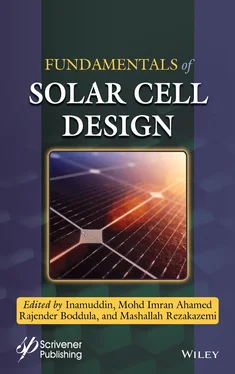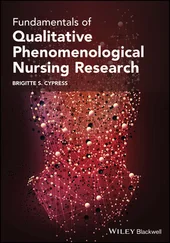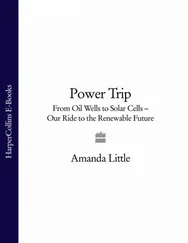1 ...6 7 8 10 11 12 ...28 Oh Kyu Kwon et al. developed a non-fullerene base material PV device which exhibited a good percent of photo current ( Figure 1.13 ). PPDT2FBT, a very well ordered polymer, was used as donor and NIDCS-HO, a small acceptor molecule for building a solar cell device [10]. Interestingly, absorption spectra for polymer donor and small-molecule acceptor displayed complementary absorption, by covering 350- to 700-nm region. Non-fullerene–based conventional single solar cell device adopted structure was given as: ITO/PEDOT:PSS/active layer/Ca/Al. Blend film morphology was investigated systematically using charge mobility data, AFM, TEM, GIWACS, annealing temperature and other techniques. Device PV parameters determined were: Voc = 1.03 V; Jsc = 11.88 mA; FF = 63%; PCE = 7.64%. Investigations indicated complementarity in absorption and suitably placed energy levels along with good film morphology can contribute to the solar cell efficiency.
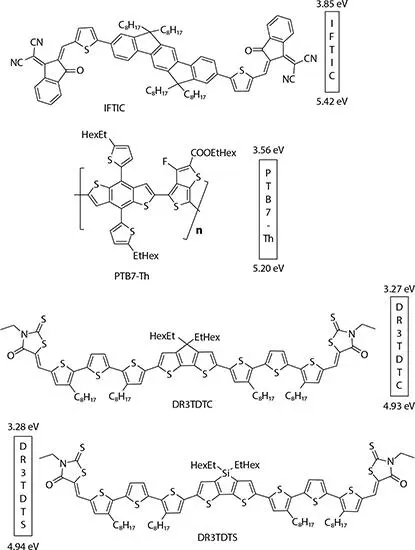
Figure 1.12 Bifluerene-dicyanoindenone.
Sunsun Li et al. synthesized a series of novel methoxyl-modified dithieno[2,3-d:2ʹ,3ʹ-dʹ]- s -indaceno[1,2-b:5,6-bʹ]dithiophene-based (ITIC based) low band gap small-molecule acceptors, IT-OM-1, IT-OM-2, IT-OM-3, and IT-OM-4 ( Figure 1.14), with A-D-A architecture, for the purpose of developing non-fullerene–based organic solar cells [11]. Position of “methoxy” substitutent on terminal group was systematically varied to understand the positional effect of substitution on optical, electrochemical, charge mobility, and more importantly molecular packing of these isomers. Donor molecule used in these investigations was PBDB-T polymer. PBDB-T donor blended with IT-OM acceptor film morphology was thoroughly investigated using AFM, GIWACS, TEM and charge mobility techniques. Devices were fabricated by adopting conventional cell configuration like: ITO/ZnO/active layer/MoO3/Al to evaluate PV parameters and in particular PCE. Additive 1,8-diodooctane was employed in these fabrications and also annealed at 150°C to make the film. The donoracceptor blend exhibited excellent UV-Visible absorption covering 350- to 800-nm region. Among the four isomers synthesized, IT-OM-2 demonstrated excellent PV parameters like: Voc = 0.93 V; Jsc = 17.53 mA; FF = 73%; PC efficiency of 11.9%. Furthermore, the PCE of >10% maintained when the thickness of the solar cell increased to 250 nm for IT-OM-2 blend system. Authors claim that it is possible to modulate intrinsic molecular properties and also bulk film morphology to achieve excellent PCE in solar cells by designing molecules for fullerene free solar cells.

Figure 1.13 Dialkoxybenzene core–based molecule.
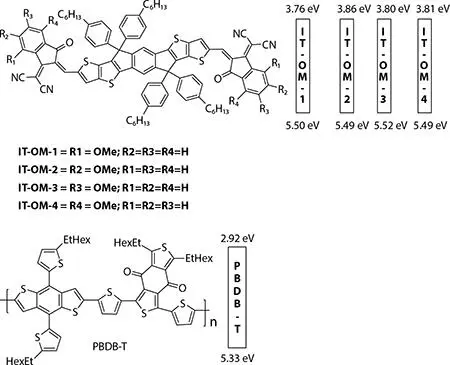
Figure 1.14 Fused seven membered ring - methoxydicyanoindenones.
Huanran Feng et al. described the synthesis of a new non-fullerene A-D-A–type low band gap acceptor small-molecule—FDNCTF ( Figure 1.15) [12]. Linearly fused seven rings, three five-membered, two thiophene, and two benzene rings, acting as donor and with electron withdrawing end group (NINCN) flanked on either side of the molecule (FDNCTF) was designed. Properties of FDNCTF were (i) UV-visible absorption reaching near infrared with high molar absorption coefficient (~3 × 10 5L mol −1), (ii) exhibited higher charge mobility, and (iii) more ordered arrangement of molecules in the film state, besides other properties. PBDB-T polymer having wide band gap acting as donor was employed for fabricating solar cells with FDNCTF. The solar cell devices were fabricated and the photo voltaic parameters were determined by adopting convention device architecture like ITO/PEDOT:PSS/PBDB-T:FDNCTF/PDINO/Al (PDINO is a cathode interlayer). FDNCTF as a small-molecule low band gap acceptor displayed impressive efficiency of 11.2%. PCE along with other parameters like Voc = 0.93V, Jsc = 16.5 mA, and FF = 72.7%. For comparison purpose, they fabricated solar cell device with FDICTF as small-molecule low band gap acceptor with PBDB-T polymer as donor to understand structural aspects of small molecule on the solar cell efficiency. Interestingly, FDICTF with PBDB-T exhibited 10.06% showcasing the better design of FDNCTF in performance. FDNCTF and PBDB-T blend transient absorption studies indicated that charge mobility was very good as correlated with film morphology. These investigations highlighted that the molecular design with larger and conjugated electron withdrawing end groups improved absorption, molecular packing in the film state which, in turn, improved the solar cell efficiency.
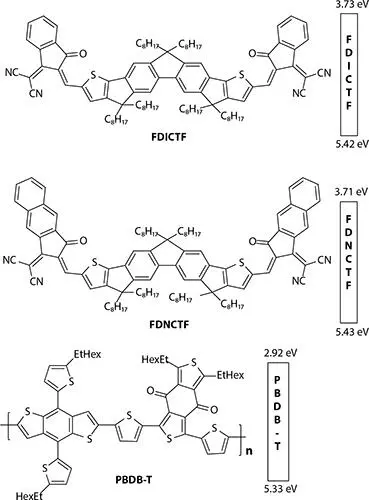
Figure 1.15 Fused seven membered ring - dicyanoindenones.
Feng Liu et al. synthesized low band gap small molecule-ATT1as a non-fullerene acceptor, where dicyano-rhodanine group was attached on both sides of ATT1 ( Figure 1.16) [13]. PTB7-Th polymer was selected as a donor in these studies. Solar cell device fabrication adopted a conventional procedure like ITO/PEDOT:PSS/PTB7-Th:ATT-1/PFN/Al. PV parameters determined were: Voc = 0.88V, Jsc = 16.18 mA, FF = 68%, and PCE = 9.78% at a film thickness of 100 nm, the efficiency was found to be increased when the film thickness increased to 130 nm—Voc = 0.87V, Jsc = 16.48 mA, FF = 70%, and PCE = 10.07%. But the efficiency decreased to 9.59% at a film thickness of 160 nm. Central core structure of the molecule ATT1 was more planar, had a high molar absorption coefficient, good charge transporting quality and facilitated film forming with good morphology. Authors believe that this design has capabilities to take forward.

Figure 1.16 Fused five membered ring - thienothiophene dicyanorhodanine.
Yuvraj Patil et al. designed and synthesized two low band gap small non-fullerene acceptor molecules DPP7 and DPP8 ( Figure 1.17) and investigated their solar cell parameters [14]. Diketopyrrolopyrrole and tetracyano-diene fragments acted as acceptor and carbazole moiety represents as donor part leading to D-A-D type architecture. Polymer was employed as donor material in the solar cell fabrications. The complimentary absorption of polymer-donor gives wide absorption for the blend. The configuration of the solar cell fabricated was: ITO/PEDOT:PSS/ P: DPP7or DPP8/PFN/Al. PV parameters obtained for DDP7 was 4.86% efficiency and for DPP8 was 7.19% efficiency. It was informed that the superior performance of DPP8 was due to its structure, which contributed mainly to the morphology of the film as well as to the betterment of the charge mobility.
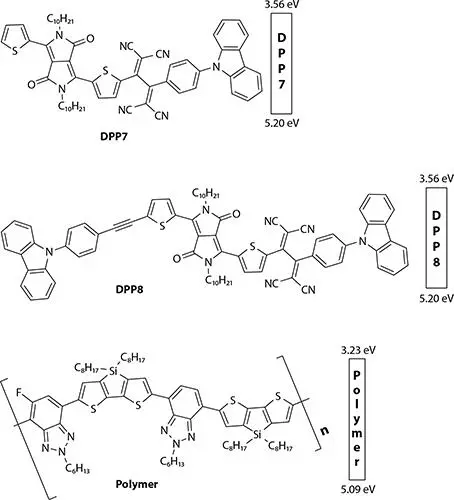
Figure 1.17 DPP-thiophene-tetracyanobutadiene-carbazole hybrid.
Jia Sun et al. synthesized two ultralow band gap small non-fullerene acceptor molecules, INPIC and INPIC-4F ( Figure 1.18) [15]. These are interesting molecules in terms of design that there are contiguously nine rings fused together to form donor part of the molecule and flanked on either side by electron withdrawing groups like dicyano-indenone (INPIC) and dicyano-difluro-indenone, making them as A-D-A–type architecture. INPIC and INPIC-4F exhibited absorptions in 600- to 900-nm region, thereby complementing with the PBDB-T polymer acting as donor, and further the blend of donor-acceptor absorption encompassed 350 to 900 nm. Solar cell devices were fabricated according to the given configuration: ITO/ZnO/active layer/MoO3/Ag and the PV parameters were as follows: INSPIC-4F displayed impressive parameters Voc = 0.85V, Jsc = 21.6 mA, FF = 71.5%, PCE = 13.13%, whereas INSPIC showed only 4.31% efficiency. The difference between the two molecules INSPIC and INSPIC-4F was “fluoro” substitution and the same was reflected in solar cell efficiency improving from 4.31% to 13.13%. INSPIC-4F/PBDB-T blend morphology exhibited well defined texture, high charge mobility, and improved light absorption property, which were cited in favor of excellent efficiency shown by the INSPIC-4F.
Читать дальше
